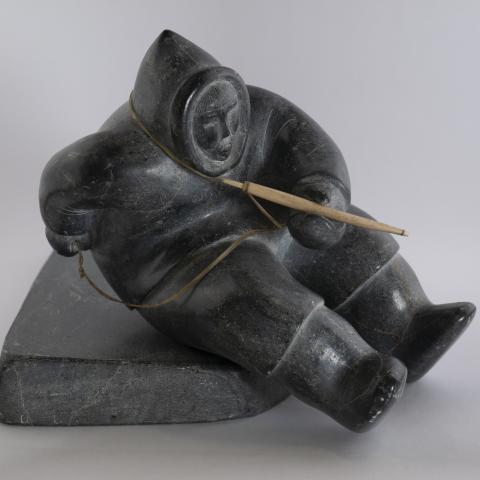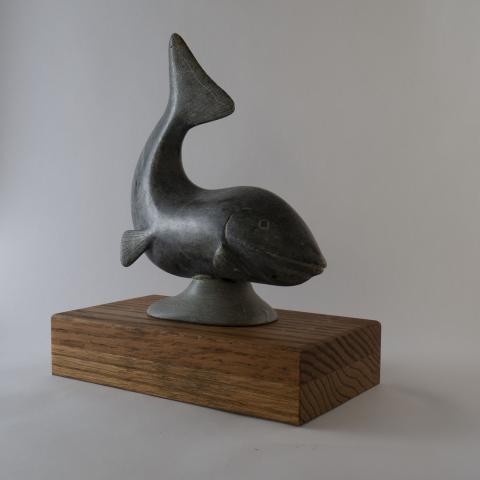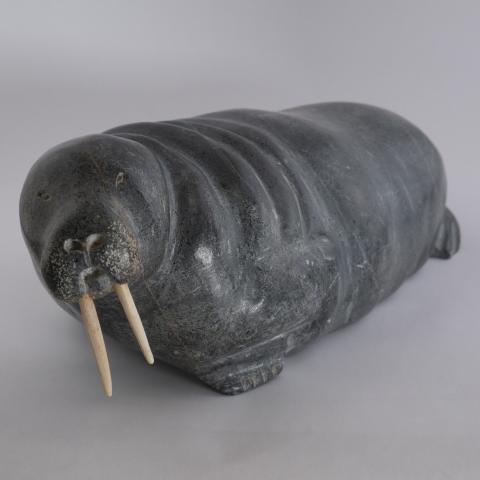Art of the Inuit People: Western Gallery Small Sculpture Collection
Art by Inuit people
1800 BCE to contemporary 1960s
stone carvings with other natural materials
Location: Western Libraries, (Haggard 3)
Description
The word Inuit means “the people.” In Inuktitut, the language of the Inuit people. Inuktitut is intrinsically tied to their oral tradition of recounting history and important stories. The traditional Inuit were a hunting-based semi-nomadic people organized into a number of regional tribal groups. Small groups and extended families often traveled together while pooling their resources and expertise to live in the Arctic (Hessel and Hessel 1998). The animals of the Arctic such as caribou, seals, polar bears, fish and birds provided the Inuit people with food, raw materials for tools and weapons, clothes and shelter, fuel, and transportation. The Inuit people occupied a large area that stretches over a million square acres. This land covers much of what is now Southern Canada as well as the arctic. The Artic is characterized by its cold weather and arid landscape. Despite the harsh environment, this area is home to more than 800 plant species, several hundred animal species, and a few dozen bird species (Crandall 2000).
Prehistoric Inuit Art
The Pre-Dorset Era: 1800 BCE to 800 BCE
Only ten Pre-Dorset artifacts have been discovered, so archaeologists know very little about this era of art (Hessel and Hessel 1998). Among the objects that have been classified as works of art are a polished bone object with cross-hatching, a tiny seal made of carved ivory, a number of objects with geometric patterns etched into them, and the fragments of three small masks that were sliced in half on purpose (Auger 2005). With the incorporation of elements from Alaskan and possibly other Native American cultures, the Pre-Dorset style of art eventually transitions into the art style of the Dorset era (Hessel and Hessel 1998).
The Dorset Era: 800 BCE to 1450 CE
Dorset carvings and other forms of art were made from bone, antler, ivory and occasionally wood and soapstone. Three-dimensional carvings, carvings done on objects such as tools, and the reflection of shamanism in this type of art are three facets of art from the Dorset era (Crandall 2000). In naturalistic and stylized forms, three-dimensional sculptures from Dorset sites depict both humans and animals. Naturalistic animal carvings are extremely detailed, while stylized animal carvings may combine many forms, such as portrayals of humans as bears and seals. Although bears and sea mammals have been discovered most frequently, Dorset carvings depicted almost every sort of animal found in the Arctic, even insects (Crandall 2000).
The Thule Era: 1000 CE to 1600 CE
Thule art typically has a more practical design and lacks the elaborate details and ornamentation found in Dorset art. On quite a few of their works of art, the Thule people etched lines, dots, patterns, and straightforward human figures (Crandall 2000). It has been discovered that knives and bow drills are decorated to show hunting and camp scenes. There are also engravings that have been found on pendants, thimble holders, men's knives, women's combs, harpoon heads, handles, and bow drills (Hessel and Hessel 1998).
Historic Inuit Art
The 1770s marked the start of the Historic Period, which lasted until the 1940s. Through interactions with whalers, traders, and missionaries, the Inuit were gradually introduced to Europeans at this time. These visitors began collecting Inuit artwork and artifacts around this period, with the preferred themes being classic scenes of Inuit life and culture in the Arctic (Hessel and Hessel 1998). The style and subject matter of the works that were being produced were significantly impacted by this. The Inuit responded to this need by making items specifically for trade with foreigners because they were understandably unwilling to part with or sell their own symbols of tradition and power. These items' style got more intricate and delicate because they were never intended to be transported from camp to camp every year. Although the substance of Historic Period art still mostly reflected traditional life and ideas, artists started to choose and display that content in an illustrated way to appeal to outside audiences. By the middle of the 1800s, the Inuit were primarily producing art for the "tourist" market (Auger 2005). Larger pieces were made and were given a base or stand, turning them into tabletop display objects instead of tiny pieces that could fit into the palm of your hand. The most popular products included cribbage boards, dice, games, models, and toys. As well, during this time, the first watercolor paintings and pencil sketches by Inuit peoples were created to be sold (Crandall 2000).
Contemporary Inuit Art
The Contemporary Period of Inuit art officially began when James Houston, a young European artist, first presented Inuit art to the Canadian Handicrafts Guild in Montreal in 1949, (Auger 2005). The guild urged him to go back up to the Arctic to buy additional Inuit artifacts, and they later funded an exhibition in Canada to showcase those carvings. The Canadian federal government recognized the potential advantages of promoting Inuit artwork as a means of fostering economic growth in the Canadian Arctic (Pupchek 2001). The 1950s and 1960s saw the emergence of Inuit-owned co-operatives in numerous Arctic villages, encouraged by Southern Canadian marketing activities. Inuit art would become a well-known Canadian contemporary art form that gained interest from around the world as a result of the marketing of Inuit art in Canada (Hessel and Hessel 1998).
During this time, there was such a tremendous demand for Inuit carvings that there simply wasn't enough of the customary carving material, ivory, to meet the demand. Soapstone carving took the role of ivory carving as the preferred medium because stone was more accessible and less expensive than ivory. As a result, the average carving size increased, which was supported by collectors. Ivory is only generally used to carve decorative elements like faces, tusks, or tools (Crandall 2000).
Bibliography
- Auger, Emily E. 2005. The Way of Inuit Art: Aesthetics and History in and beyond the Arctic. Jefferson, N.C: McFarland.
- Crandall, Richard C. 2000. Inuit Art: A History. Jefferson, N.C: McFarland.
- Hessel, Ingo, and Dieter Hessel. 1998. Inuit Art: An Introduction. New York: Harry N. Abrams.
- Pupchek, Leanne Stuart. 2001. “True North: Inuit Art and the Canadian Imagination.” American Review of Canadian Studies 31 (1–2): 191–208.
Research, writing, and exhibition installation conducted by Western Gallery intern Ashelyn Holm, 2023.


